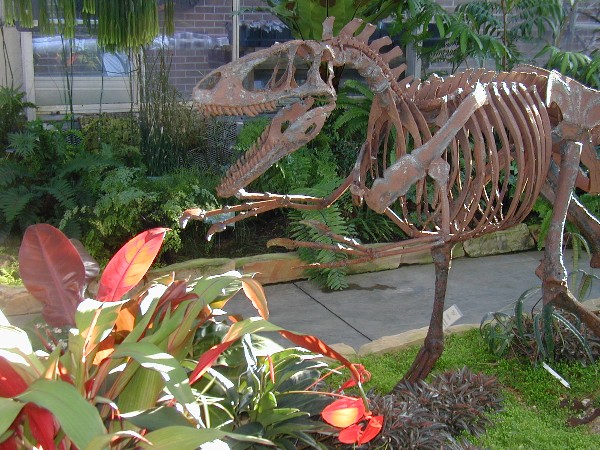 Walking on campus last month I spotted an acquaintance I had long overlooked—a Kentucky Coffee tree, Gymnocladus dioicus. It’s small and easy to miss most of the year, but one characteristic stood out—the ear-sized seedpods that had clung to its branches well into the Spring. Early American caffeine addicts ground up its large seeds to make a coffee substitute.
Walking on campus last month I spotted an acquaintance I had long overlooked—a Kentucky Coffee tree, Gymnocladus dioicus. It’s small and easy to miss most of the year, but one characteristic stood out—the ear-sized seedpods that had clung to its branches well into the Spring. Early American caffeine addicts ground up its large seeds to make a coffee substitute. 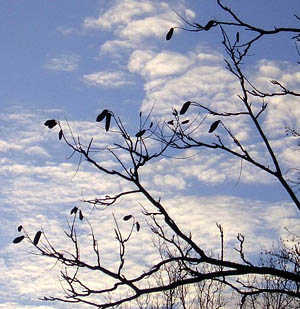 If they got a buzz it wasn’t from caffeine–a novel amino acid makes up 5% of the seed contents (dry weight), probably toxic to the Bruchid beetles that plague most other Leguminosae (Janzen, 1969), but a welcome winter snack for a hungry mastodon or ground sloth. G. dioicus shows all indications of being an ice age orphan–left hanging by its normal dispersers (Barlow, 2000). Native Americans may have saved the tree from extinction by spreading the seeds for food or perhaps to use for recreation (Van der Linden and Farrar, 1984). (tree photo borrowed from)
If they got a buzz it wasn’t from caffeine–a novel amino acid makes up 5% of the seed contents (dry weight), probably toxic to the Bruchid beetles that plague most other Leguminosae (Janzen, 1969), but a welcome winter snack for a hungry mastodon or ground sloth. G. dioicus shows all indications of being an ice age orphan–left hanging by its normal dispersers (Barlow, 2000). Native Americans may have saved the tree from extinction by spreading the seeds for food or perhaps to use for recreation (Van der Linden and Farrar, 1984). (tree photo borrowed from)
Category Archives: Sloth Park
Ghosts on a subcontinent
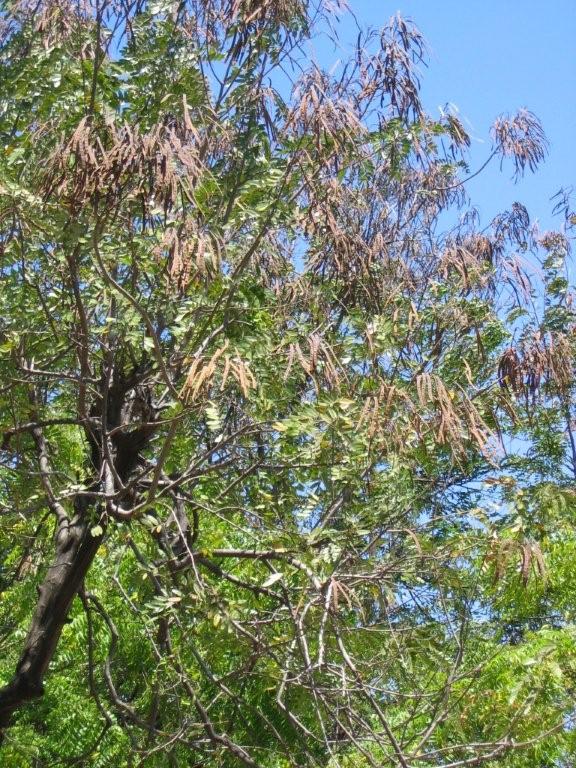 I found an interesting parallel to the honey locust story featured in “Sloth Music” in the central square of Granada, Nicaragua where there was a tree with seed pods that looked like those of a honey locust (the leaves are different). I asked our guide about it and he said that it was a melinche tree. He knew his stuff because he wrote the genus and species (Delonix regia) on the back of an envelope. He noted that as a child he and his friends would climb the melinches to collect the longest seed pods which invariably were at the top of the tree. They used them as swords because they liked the accompanying rattle (dinner bells!) during their games. I googled the tree and found that they are in the same family (Fabaceae) as the honey locust. Delonix is now endangered in the wild but is spread worldwide in the tropics as an ornamental tree, the Royal Poinciana. Recall that the honey locust also had a restricted range until it became a popular shade tree in North America.
I found an interesting parallel to the honey locust story featured in “Sloth Music” in the central square of Granada, Nicaragua where there was a tree with seed pods that looked like those of a honey locust (the leaves are different). I asked our guide about it and he said that it was a melinche tree. He knew his stuff because he wrote the genus and species (Delonix regia) on the back of an envelope. He noted that as a child he and his friends would climb the melinches to collect the longest seed pods which invariably were at the top of the tree. They used them as swords because they liked the accompanying rattle (dinner bells!) during their games. I googled the tree and found that they are in the same family (Fabaceae) as the honey locust. Delonix is now endangered in the wild but is spread worldwide in the tropics as an ornamental tree, the Royal Poinciana. Recall that the honey locust also had a restricted range until it became a popular shade tree in North America.
A sloth garden for Marion
The city of Marion is soliciting ideas from local residents and other interested parties for improving city life and strengthening its identity in a program they are calling Imagine8. I’ve been working with a group of friends and supporters of the Eastern Iowa Paleontology Project (EIPP) to develop a statement encouraging an initiative to improve natural science education in the city. We all agree it would be very nice if we can create a permanent home for our dinosaur in the process, but more important is encouraging science education. You would think with the shortage of engineers, scientists, doctors and other health professionals in this country and our pressing environmental needs that there would be more support for teachers and families wanting to encourage their children in this direction but science funding always trails far behind that for culture and the arts. Since Cedar Rapids hasn’t called me yet about redeveloping their flooded downtown area into an Ice Age Sloth Park , I’m planning to dust off the idea for Marion and propose it as part of a general botanical center.
Sloth music
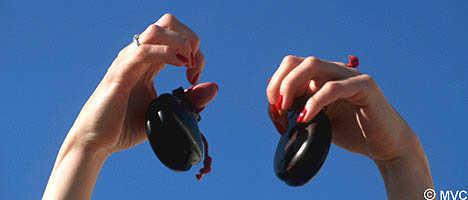 We’re like Goldilocks wandering around in the cottage of The 3 Sloths—the table is set, the beds are made and the TV is on—maybe the owners are out in back . . . but we’re pretending they’re gone forever and we’re in control now. Look around—sloths may be extinct, but they aren’t dead! We’re surrounded by signs of their lingering presence, and the continuing performance of many of their Ice Age co-stars. Applaud Blue Jays today for our oak trees. Admire the Osage Orange that still grows a formidable sloth defense. And grieve for the lonely Honeylocust that still cries out every fall for the sloths to return. (photo borrowed from)
We’re like Goldilocks wandering around in the cottage of The 3 Sloths—the table is set, the beds are made and the TV is on—maybe the owners are out in back . . . but we’re pretending they’re gone forever and we’re in control now. Look around—sloths may be extinct, but they aren’t dead! We’re surrounded by signs of their lingering presence, and the continuing performance of many of their Ice Age co-stars. Applaud Blue Jays today for our oak trees. Admire the Osage Orange that still grows a formidable sloth defense. And grieve for the lonely Honeylocust that still cries out every fall for the sloths to return. (photo borrowed from)
Picky eaters shouldn’t be surprised when they go extinct
 Fussy birds get what they deserve—that’s how some ornithologists explain the demise of birds like the Ivory-billed Woodpecker (Campephillus principalis) (Shugart, 2004). Ivory-bills foraged for insects by prying up the bark of large trees, leaving it to other woodpeckers to probe the deeper reaches. There’s a limited supply of suitably-clad trees so the birds needed large territories—at least 36 miles2 by one account (ibid.). Under this scenario agricultural land-clearing and hunting were just the final nails-in-the-coffin. One might be skeptical of explanations of extinction that blame the victim for choosing an unreliable niche. Trees die for many reasons–senescence, lightning, disease, over-browsing, floods, droughts, ice, wind-throw . . . all contributing to the dynamic patchwork that characterizes a healthy diverse woodland. The birds wouldn’t have evolved their habits if they didn’t have a reliable food-supply for millions of years and the behavioral elasticity to take advantage of the opportunities that arose and
Fussy birds get what they deserve—that’s how some ornithologists explain the demise of birds like the Ivory-billed Woodpecker (Campephillus principalis) (Shugart, 2004). Ivory-bills foraged for insects by prying up the bark of large trees, leaving it to other woodpeckers to probe the deeper reaches. There’s a limited supply of suitably-clad trees so the birds needed large territories—at least 36 miles2 by one account (ibid.). Under this scenario agricultural land-clearing and hunting were just the final nails-in-the-coffin. One might be skeptical of explanations of extinction that blame the victim for choosing an unreliable niche. Trees die for many reasons–senescence, lightning, disease, over-browsing, floods, droughts, ice, wind-throw . . . all contributing to the dynamic patchwork that characterizes a healthy diverse woodland. The birds wouldn’t have evolved their habits if they didn’t have a reliable food-supply for millions of years and the behavioral elasticity to take advantage of the opportunities that arose and  overcome challenges. Something significant altered the woodland disturbance regime. In that gap, and missing from the list above may reside an ice age ghost–keystone mega-herbivores that played a critical role in ancient forests–as the giants do today wherever they have survived (Owen-Smith, 1987). (picky eater photo borrowed from, woodpecker photo borrowed from)
overcome challenges. Something significant altered the woodland disturbance regime. In that gap, and missing from the list above may reside an ice age ghost–keystone mega-herbivores that played a critical role in ancient forests–as the giants do today wherever they have survived (Owen-Smith, 1987). (picky eater photo borrowed from, woodpecker photo borrowed from)
Voices in the forest: echos of the ice age
The Pleistocene mass-extinction left a number of  plants and animals ill-adapted to modern life—trees with fruit or seeds too large to be swallowed and transported (Janzen and Martin, 1982), with outmoded defenses (Barlow, 2000), or waiting endlessly for agents of disturbance that are no more. They are the survivors of vanished communities, still reflecting the forces under which they evolved for hundreds of thousands of years, and often in decline today. They are the ghosts and orphans of the Ice Age. I have seen an ice age ghost, and it’s a nightmare! (image borrowed from)
plants and animals ill-adapted to modern life—trees with fruit or seeds too large to be swallowed and transported (Janzen and Martin, 1982), with outmoded defenses (Barlow, 2000), or waiting endlessly for agents of disturbance that are no more. They are the survivors of vanished communities, still reflecting the forces under which they evolved for hundreds of thousands of years, and often in decline today. They are the ghosts and orphans of the Ice Age. I have seen an ice age ghost, and it’s a nightmare! (image borrowed from)
Seeds for thought
 We’ve received our preliminary reports on the fossil seeds and pollen from . The seeds are what you would expect to find in the backwater-areas of a river—wetland taxa and weedy types profiting from the local disturbances. The pollen report is intriguing though– oak, pine, cedar and hickory, with some more weeds and lowlanders tossed in. A couple of things stand out—of course there are many different kinds of oaks and pines, etc., each with its own requirements, but generally they all need large doses of direct sunshine to grow. Their seedlings don’t survive in the shade. We found the tip of one spruce needle, but this doesn’t add up to being a dense boreal spruce forest. With oaks and hickories, etc., it feels a lot like the Iowa we know—different species possibly, but in form and type of trees, the landscape we inherited from the Native Americans 150 years ago. Photo borrowed from)
We’ve received our preliminary reports on the fossil seeds and pollen from . The seeds are what you would expect to find in the backwater-areas of a river—wetland taxa and weedy types profiting from the local disturbances. The pollen report is intriguing though– oak, pine, cedar and hickory, with some more weeds and lowlanders tossed in. A couple of things stand out—of course there are many different kinds of oaks and pines, etc., each with its own requirements, but generally they all need large doses of direct sunshine to grow. Their seedlings don’t survive in the shade. We found the tip of one spruce needle, but this doesn’t add up to being a dense boreal spruce forest. With oaks and hickories, etc., it feels a lot like the Iowa we know—different species possibly, but in form and type of trees, the landscape we inherited from the Native Americans 150 years ago. Photo borrowed from)
Ice Age shadows and a vision for the future
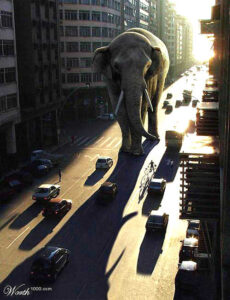 Cedar Rapids has released its plan for restoring the neighborhoods ravaged by this summer’s floods. I’m disappointed. I was hoping for a bolder vision, something that recognized the increased likelihood of future floods and turned the riverfront in a more sustainable direction—like an Ice Age Zoological Park recreating the sloths’ habitat. Besides serving as an important tool for education and research about Iowa’s truly natural environment (i.e. before Native American alterations to the land) and a valuable wildlife corridor, a natural environment park would bring significant commercial development opportunities, tourist revenue and jobs. A riverfront park could be designed to meet the Cedar River half way and work with its perennial floods instead of against them, like the truce Davenport, IA has forged with the Mississippi. Restored wetlands, lakes and other containment basins could absorb water rather than speeding its way onward to create bigger problems for the communities downstream. Large urban zoological parks aren’t without precedent. The 1,800-acre San Diego Zoo Wild Animal Park is one of the largest tourist attractions in southern California with attendance of 2 million visitors annually (Wikipedia, 2008). Why not here? (image One Way Street by bpkelsey, borrowed from)
Cedar Rapids has released its plan for restoring the neighborhoods ravaged by this summer’s floods. I’m disappointed. I was hoping for a bolder vision, something that recognized the increased likelihood of future floods and turned the riverfront in a more sustainable direction—like an Ice Age Zoological Park recreating the sloths’ habitat. Besides serving as an important tool for education and research about Iowa’s truly natural environment (i.e. before Native American alterations to the land) and a valuable wildlife corridor, a natural environment park would bring significant commercial development opportunities, tourist revenue and jobs. A riverfront park could be designed to meet the Cedar River half way and work with its perennial floods instead of against them, like the truce Davenport, IA has forged with the Mississippi. Restored wetlands, lakes and other containment basins could absorb water rather than speeding its way onward to create bigger problems for the communities downstream. Large urban zoological parks aren’t without precedent. The 1,800-acre San Diego Zoo Wild Animal Park is one of the largest tourist attractions in southern California with attendance of 2 million visitors annually (Wikipedia, 2008). Why not here? (image One Way Street by bpkelsey, borrowed from)

